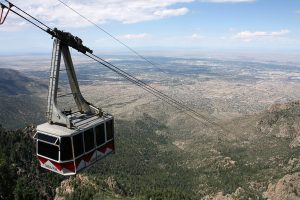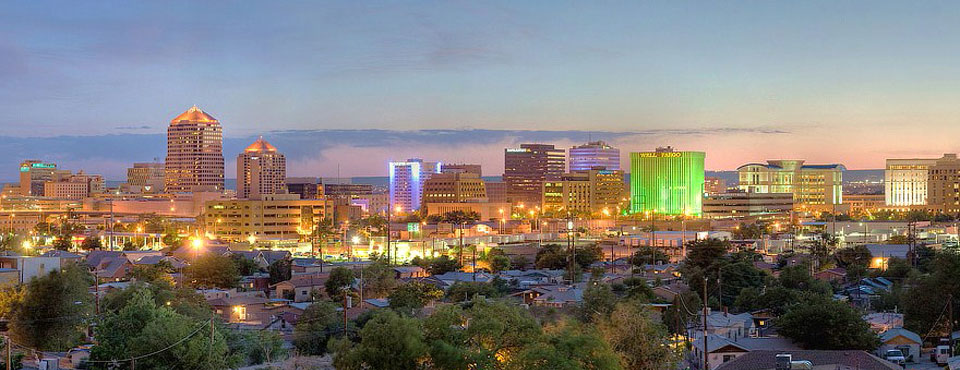Albuquerque is the largest city in the state of New Mexico, United States. It is the county seat of Bernalillo County and is situated in the central part of the state, straddling the Rio Grande. The Albuquerque metropolitan area had 923,630 residents in July 2020.[4] The area includes Rio Rancho, Bernalillo, Placitas, Zia Pueblo, Los Lunas, Belen, South Valley, Bosque Farms, Jemez Pueblo, Cuba, and part of Laguna Pueblo.
Albuquerque is home to the University of New Mexico (UNM), Kirtland Air Force Base, Sandia National Laboratories, and Petroglyph National Monument, to name a few. Albuquerque lies at the center of the New Mexico Technology Corridor, a concentration of high-tech private companies and government institutions along the Rio Grande. The Sandia Mountains run along the eastern side of Albuquerque, and the Rio Grande flows through the city, north to south.
Albuquerque hosts the Albuquerque International Balloon Fiesta, the world’s largest gathering of hot-air balloons, taking place every October at Balloon Fiesta Park, with its 47-acre launch field.
Albuquerque also contains a variety of museums, galleries, shops and other points of interest. Some of these include theAlbuquerque Biological Park,Albuquerque Museum of Art and History, Museum of Natural History and Science, and Old Town Albuquerque. The majority of locally owned boutiques and fine dining establishments are scattered throughout Downtown, Old Town, and Uptown. Old Town features ghost tours performed by the Southwest Ghosthunters Association. Albuquerque also has a variety of live music/performance venues including Isleta Amphitheater, Sunshine Theater and the KiMo Theater.
 The Sandia and Manzano Mountains to the east offer trails, open spaces, and rock climbing. Climbs from one to ten pitches can be found at all ability levels. Sandia Peak Ski Area, adjacent to Albuquerque, provides both winter and summer recreation in the Sandia Mountains. It features Sandia Peak Tramway, the world’s second-longest passenger aerial tramway, and the longest in the Americas. It stretches from the northeast edge of the city to Sandia Peak, the summit of the ski resort, and has the world’s third-longest single span. Elevation at the summit is roughly 10,300 ft (3,100 m) above sea level, or “ten-three”. There is also a restaurant, TEN 3, at the top of the tramway.
The Sandia and Manzano Mountains to the east offer trails, open spaces, and rock climbing. Climbs from one to ten pitches can be found at all ability levels. Sandia Peak Ski Area, adjacent to Albuquerque, provides both winter and summer recreation in the Sandia Mountains. It features Sandia Peak Tramway, the world’s second-longest passenger aerial tramway, and the longest in the Americas. It stretches from the northeast edge of the city to Sandia Peak, the summit of the ski resort, and has the world’s third-longest single span. Elevation at the summit is roughly 10,300 ft (3,100 m) above sea level, or “ten-three”. There is also a restaurant, TEN 3, at the top of the tramway.
Recognized as one of the most culturally diverse cities in the country, Albuquerque’s Mexican, Spanish, Native and Anglo populations have contributed greatly to its architecture, artwork, and its cuisine. The state question “Red or Green?” has to do with how people like their chile—the traditional roasted hatch green chile from southern New Mexico (particularly Hatch), or the dark rich smoky red chile from Northern New Mexico. Albuquerque also includes strong African American, Asian, Middle Eastern and other ethnic communities, creating a unique and modern Southwestern blend comprising more than 70 ethnicities. The growing International District offers restaurants of many of these cultures.
In terms of gay and lesbian culture, Albuquerque and Santa Fe have some of the largest gay and lesbian populations per capita of any cities in the U.S. As of 2011, Santa Fe ranked # 7 in the country for number of same-sex couples living together on a per capita basis, and Albuquerque was #22.
Albuquerque has a rich and growing film industry, and has been featured in Hollywood movies such as Sunshine Cleaning, Little Miss Sunshine, The Muppet Movie, The Avenger, Brothers and A Million Ways to Die in the West. Numerous television shows have also been filmed in Albuquerque, including Breaking Bad, Better Call Saul, Stranger Things, Speechless, Daybreak and In Plain Sight.


Comments are closed, but trackbacks and pingbacks are open.